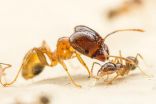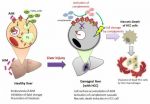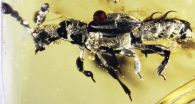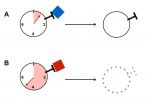(Press-News.org) CHAMPAIGN, Ill. — The big-headed ant (Pheidole megacephala) is considered one of the world's worst invasive ant species. As the name implies, its colonies include soldier ants with disproportionately large heads. Their giant, muscle-bound noggins power their biting parts, the mandibles, which they use to attack other ants and cut up prey. In a new study, researchers report that big-headed ant colonies produce larger soldiers when they encounter other ants that know how to fight back.
The new findings appear in the Biological Journal of the Linnean Society.
Big-headed ants are world travelers, hitching rides with humans to get around. Scientists have found them in more than 1,600 sites across the globe (see map). Their arrival at a sufficiently warm destination (they cannot tolerate cold weather) spells almost certain doom for native ants, spiders, beetles and other invertebrates that are unaccustomed to their brand of warfare.
"If you think about the worst invasive species, ants frequently show up on those lists, and big-headed ants are among the most problematic," said University of Illinois entomology professor and animal biology department head Andrew Suarez, who led the new study with postdoctoral researcher Bill Wills. "They are very aggressive. And unlike a lot of native ants, they produce large numbers of queens, so they have incredibly high potential for reproduction."
Big-headed ants spread out, assembling multiple nests that cooperate on defense, reproduction, territorial expansion and food procurement, the researchers said.
Soldiers and non-soldiers in a Pheidole megacephala colony are sisters, so genetic changes do not account for their differing morphology. Changes in nutrition during development are primarily responsible for their different shapes and sizes, Suarez said.
"We know that you can feed larvae differentially and that will change hormone levels that will cause a completely different developmental pathway to turn on, so you get this giant head, you become a big-headed ant rather than a small worker," he said.
The team wanted to know if environmental cues, such as the presence of other aggressive ants, would cause the big-headed ant colonies to produce more, or bigger, soldiers. To study this, they looked at the ants in five locales: Australia, Florida, Hawaii, Mauritius (an island off the southeast coast of Africa) and South Africa.
"Hawaii is interesting because there are no native ants there, so a lot of the local insect and arthropod fauna are not necessarily adapted to dealing with social insects," Wills said. "But the native ant fauna in Australia is very dominant and diverse."
The study sites in Florida, Mauritius and South Africa represent a kind of intermediate condition, where the big-headed ants encounter competitors that are not as fierce or diverse as the ants of Australia, he said.
The team found that big-headed soldiers and non-soldiers grew largest in Australia and smallest in Hawaii. On average, the Australian big-headed ant soldiers were three times more massive than their equivalents in Hawaii, Wills said. The ants at the other study sites were intermediate in size.
Genetic analysis showed that the ants from all the study sites were closely related, Suarez said, ruling out the possibility that size variation was the result of long-term evolutionary change.
"This shows that they were able to adapt to a new environment relatively quickly," Suarez said. "It's kind of exciting and scary that it can happen so quickly."
(In a separate study, Wills found that fire ants can begin to morph their body size within 60 days in a new environment.)
The big-headed ants produced bigger workers in response to external cues, but they did not generate a larger share of soldiers in any of the sites, Suarez said.
"We found that the ratios of soldiers to non-soldiers were relatively constant across our populations," he said.
The researchers hypothesize that the ants use chemical signals called pheromones to determine when the nest has the right proportion of soldiers to other workers. If this turns out to be the case, scientists may be able to control the ants with chemical signals without disrupting the surrounding ecology, Suarez said.
INFORMATION:
The National Science Foundation supported this research.
Editor's notes:
To reach Andrew Suarez, call 217-244-6631; email suarez2@illinois.edu.
To reach Bill Wills, email bwills2@life.illinois.edu.
The paper, "Body size variation and caste ratios in geographically distinct populations of the invasive big-headed ant, Pheidole megacephala (Hymenoptera: Formicidiae)," is available online or from the U. of I. News Bureau.
London, United Kingdom, October 2, 2014 – Despite decades of research, scientists have yet to pinpoint the exact cause of nodding syndrome (NS), a disabling disease affecting African children. A new report suggests that blackflies infected with the parasite Onchocerca volvulus may be capable of passing on a secondary pathogen that is to blame for the spread of the disease. New research is presented in the International Journal of Infectious Diseases.
Concentrated in South Sudan, Northern Uganda, and Tanzania, NS is a debilitating and deadly disease that affects young ...
A new study published in the Cell Press journal Current Biology on October 2 could rewrite the story of ape and human brain evolution. While the neocortex of the brain has been called "the crowning achievement of evolution and the biological substrate of human mental prowess," newly reported evolutionary rate comparisons show that the cerebellum expanded up to six times faster than anticipated throughout the evolution of apes, including humans.
The findings suggest that technical intelligence was likely at least as important as social intelligence in human cognitive ...
The more curious we are about a topic, the easier it is to learn information about that topic. New research publishing online October 2 in the Cell Press journal Neuron provides insights into what happens in our brains when curiosity is piqued. The findings could help scientists find ways to enhance overall learning and memory in both healthy individuals and those with neurological conditions.
"Our findings potentially have far-reaching implications for the public because they reveal insights into how a form of intrinsic motivation—curiosity—affects memory. These findings ...
This release is available in Japanese.
A University of Tokyo research group has discovered that AIM (Apoptosis Inhibitor of Macrophage), a protein that plays a preventive role in obesity progression, can also prevent tumor development in mice liver cells. This discovery may lead to a therapy for hepatocellular carcinoma (HCC), the most common type of liver cancer and the third most common cause of cancer deaths.
Professor Toru Miyazaki's group at the Laboratory of Molecular Biomedicine from Pathogenesis, in the Faculty of Medicine has shown that AIM (also known ...
LA JOLLA, CA—October 2, 2014—Scientists at The Scripps Research Institute (TSRI) have found that an enzyme best known for its fundamental role in building proteins has a second major function: to protect DNA during times of cellular stress.
The finding is remarkable on a basic science level but also points the way to possible therapeutic applications. Strategies that enhance the DNA-protection function of the enzyme, TyrRS, could help protect people from radiation injuries as well as from hereditary defects in DNA repair systems.
"We overexpressed TyrRS in zebrafish ...
Scientists have uncovered the fossil of a 52-million-year old beetle that likely was able to live alongside ants—preying on their eggs and usurping resources—within the comfort of their nest. The fossil, encased in a piece of amber from India, is the oldest-known example of this kind of social parasitism, known as "myrmecophily." Published today in the journal Current Biology, the research also shows that the diversification of these stealth beetles, which infiltrate ant nests around the world today, correlates with the ecological rise of modern ants.
"Although ants ...
Our immune system must distinguish between self and foreign and in order to fight infections without damaging the body's own cells at the same time. The immune system is loyal to cells in the body, but how this works is not fully understood. Researchers in the Departments of Biomedicine and Nephrology at the University Hospital and the University of Basel have discovered that the immune system uses a molecular biological clock to target intolerant T cells during their maturation process. These recent findings have been reported in the scientific journal Cell.
A functioning ...
It's an early lesson in genetics: we get half our DNA from Mom, half from Dad.
But that straightforward explanation does not account for a process that sometimes occurs when cells divide. Called gene conversion, the copy of a gene from Mom can replace the one from Dad, or vice versa, making the two copies identical.
In a new study published in the American Journal of Human Genetics, University of Pennsylvania researchers Joseph Lachance and Sarah A. Tishkoff investigated this process in the context of the evolution of human populations. They found that a bias toward ...
Scientists love acronyms.
In the quest to solve cancer's mysteries, they come in handy when describing tongue-twisting processes and pathways that somehow allow tumors to form and thrive. Two examples are ERK (extracellular-signal-related kinase) and JNK (c-June N-Terminal Kinase), enzymes that may offer unexpected solutions for treating some endometrial and colon cancers.
A study led by Gordon Mills, M.D., Ph.D., professor and chair of Systems Biology at The University of Texas MD Anderson Cancer Center with Lydia Cheung, Ph.D. as the first author, points to cellular ...
Television sitcoms in which characters make jokes at someone else's expense are no laughing matter for older adults, according to a University of Akron researcher.
Jennifer Tehan Stanley, an assistant professor of psychology, studied how young, middle-aged and older adults reacted to so-called "aggressive humor"—the kind that is a staple on shows like The Office.
By showing clips from The Office and other sitcoms (Golden Girls, Mr. Bean, Curb Your Enthusiasm) to adults of varying ages, she and colleagues at two other universities found that young and middle-aged adults ...







